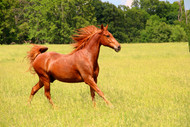Laminitis in Horses
Posted by Darren Walton on 28th Aug 2021
Around 1 in 10 horses/ponies will be affected by Laminitis[i] every year which can cause permanent damage to the hoof. Any horse, pony, donkey or their hybrids can be affected and the problem can occur at any time of the year.
Laminitis affects the laminae tissues which bond the pedal bone securely within the hoof. Laminitis causes damage to the laminae and can result in stretching and weakening of the laminae tissues. In acute cases this can allow the pedal bone to rotate or even penetrate the sole of the hoof – often the only option in such acute cases is euthanasia to prevent further suffering. Laminitis is most common in the front hooves but can affect any of the horse’s hooves.
It is important to view laminitis as a sign of disease, rather than a disease in itself and the cause needs to be investigated and managed to prevent future episodes. For example, overweight horses are more susceptible and therefore their weight must be managed to prevent development of Laminitis. There are three broad categories of disease which should be monitored due to the increased risk of Laminitis:
Hormonal Laminitis
Two hormonal diseases associated with Laminitis are Cushings Disease and Equine Metabolic Syndrome. Although it is unclear how these diseases result in the development of Laminits, it is known that horses suffering from these diseases generally show a higher than normal level of insulin in their bloodstream which is a known cause of Laminitis. Should your horse develop Laminitis it is worth testing for the presence of these diseases to rule out Cushings or EMS as a possible cause.
Inflammatory Laminitis
If the horse consumes large amounts of concentrate feed in one go, this can cause overload in the digestive system. This can result in sugars and starches being pushed through into the hind gut where it is rapidly broken down. This process results in damage to the gut and the absorption of toxins into the bloodstream. It is widely believed that these toxins disrupt blood flow to the laminae resulting in damage. The same toxin release can result from certain colic cases, lung inflammation or retain placenta.
Weight Bearing Laminitis
Should the horse suffer an injury to one of their legs, this may result in them bearing more weight on the opposite limb. The extra weight being borne by the limb which is compensating for the weakness in the opposite limb can be a cause of Laminitis.
Other Causes
There are other causes of Laminits which can include; improper foot trimming, improper shoeing, excess toe length, prolonged work on hard ground, fractures etc.
Spotting Laminitis
Signs can be as subtle as a change in temperament, reluctance to turn, shortened stride, stiffened gait, shifting weight from one foot to the other, reluctance to pick up feet. They may also be more careful on hard or stony ground, have warm hoof wall or coronet or a strong digital pulse. You may also note the classic laminitis stance where the horse rocks back onto its hind legs to take the weight of their front feet (only when back hooves are not affected).
What To Do
If you suspect that your horse is suffering from Laminitis it is important to contact your vet immediately. The animal must be treated as quickly as possible to relieve any pain. If your horse is unwilling to walk do not force it to do so. If possible move it to the closest stable or shelter. If possible create a deep shavings bed which will provide both support and cushioning. Your vet will be able to prescribe a suitable course of treatment in conjunction with your farrier.
Management
Preventing Laminitis is always easier than treating the problem:
- Feet should be picked out daily and checked for heat as well as a strong digital pulse. If there is any sign of lameness or discomfort check with your vet. Keep feet trimmed and or shod in consultation with your farrier.
- Horses should be fat/condition scored regularly to prevent your animal becoming overweight.
- Restrict the amount of grass intake rather than time at grazing (consider a grazing muzzle). Add a low sugar and starch feed balancer where necessary. It is also important to weight the forage to ensure they are getting the correct amount. Soaking of hay may help remove some sugar. Try to feed hay instead of haylage which is more palatable.
- Consider with your vet/nutritionist whether your horse would benefit from supplementation with a product specifically formulated for horses prone to Laminitis.
- Keep your horse fit – have regular health and dental checks – discuss testing for conditions which may cause abnormal hormone levels. Devise a regular exercise plan with your vet or farrier and encourage movement when turned out by placing food and water far apart.
- Horses must be kept free from pain using a suitable product prescribed by your veterinary surgeon. Horses should also be kept stimulated whilst on a restricted diet – consider enrichment which will help reduce the rate of consumption – hay rollers are a great way to achieve this.
[i] Pollard, D., Wylie, C.E., Newton, J.R., Verheyen, K.L.P. (2018) Incidence and clinical signs of owner-reported equine laminitis in a cohort of horses and ponies in Great Britain. Equine Veterinary Journal. 51(5), pp. 587-594

